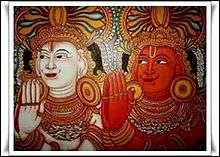Ashvins
| Ashvins | |
|---|---|
| Nasatya (elder ashvin) was God of Health and Dasra (younger ashvin) was God of Medicines | |
 Ashwini Kumaras | |
| Mount | Golden Chariot |
| Personal information | |
| Consort |
Jyoti (Goddess) (Goddess of Human body) (wife of ashivin nasatya) Mayandri (Goddess) (Goddess of Magic) (wife of ashvin dasra) |
| Children | Satyavir (son of nasatya and god of recovery), Damraj (son of dasra and god of leaves), Nakula (son of nasatya), Sahadeva (son of dasra) |
| Parents | Saranyu(Sandhya), Ushas and Surya |
| Roman equivalent | Dioscuri |
The Ashvins or Ashwini Kumaras (Sanskrit: अश्विन्, aśvin-, dual aśvinauअश्विनौ), in Hindu mythology, are two Vedic gods, divine twin horsemen in the Rigveda, sons of Saranyu, a goddess of the clouds and wife of Surya in his form as Vivasvant. Nasatya and Dasra are names of ashvins. They symbolise the shining of sunrise and sunset, appearing in the sky before the dawn in a golden chariot, bringing treasures to men and averting misfortune and sickness. They are the doctors of gods and are devas of Ayurvedic medicine. They are represented as humans with the heads of horses. In the epic Mahabharata, King Pandu's wife Madri is granted a son by each Ashvin and bears the twins Nakula and Sahadeva who, along with the sons of Kunti, are known as the Pandavas.
_LACMA_M.83.1.7_(1_of_2).jpg)
Origins
The Ashvins are analogous to the Proto-Indo-European horse twins.[1][2][3] Their cognates in other Indo-European mythologies include the Baltic Ašvieniai, the Greek Castor and Polydeuces, the English Hengist and Horsa, and the Welsh Bran and Manawydan.[1]
In Hindu sacred texts
The Ashvins are mentioned 376 times in the Rigveda, with 57 hymns specifically dedicated to them: 1.3, 1.22, 1.34, 1.46-47, 1.112, 1.116-120 (c.f. Vishpala), 1.157-158, 1.180-184, 2.20, 3.58, 4.43-45, 5.73-78, 6.62-63, 7.67-74, 8.5, 8.8-10, 8.22, 8.26, 8.35, 8.57, 8.73, 8.85-87, 10.24, 10.39-41, 10.143. The Nasatya twins are invoked in a treaty between Suppiluliuma and Shattiwaza, kings of the Hittites and the Mitanni respectively.[4]
Indian holy books like the Mahabharata and the Puranas, relate that the Ashwini Kumar brothers, the twins, who were Raja-Vaidya (Royal Physicians) to Devas during Vedic times, first prepared the Chyawanprash formulation for Chyawan Rishi at his Ashram on Dhosi Hill near Narnaul, Haryana, India, hence the name Chyawanprash.[5][6]
References
- 1 2 Mallory, J.P; Adams, D.Q. (2006). The Oxford Introduction to Proto-Indo-European and the Proto-Indo-European World. Oxford, England: Oxford University Press. p. 432. ISBN 978-0-19-929668-2.
- ↑ West, Martin Litchfield (2007). Indo-European Poetry and Myth. Oxford, England: Oxford University Press. pp. 85–91. ISBN 978-0-19-928075-9.
- ↑ Puhvel, Jaan (1987). Comparative Mythology. Baltimore, Maryland: Johns Hopkins University Press. pp. 58–61. ISBN 0-8018-3938-6.
- ↑ KBo 1 1. Gary M. Beckman (Jan 1, 1999). Hittite Diplomatic Texts. Scholars Press. p. 53. . Excerpt http://www.heritageinstitute.com/zoroastrianism/ranghaya/suppiluliuma_shattiwaza_treaty.htm
- ↑ Healthepic.com
- ↑ Panda, H; Handbook On Ayurvedic Medicines With Formulae, Processes And Their Uses, 2004, p10 ISBN 978-81-86623-63-3
- Dictionary of Hindu Lore and Legend ( ISBN 0-500-51088-1) by Anna L. Dallapiccola
- Bibliography
- Parva, Paushya. "SECTION III (Paushya Parva". Sacred Texts. pp. 32–33. Retrieved 1 November 2013.
